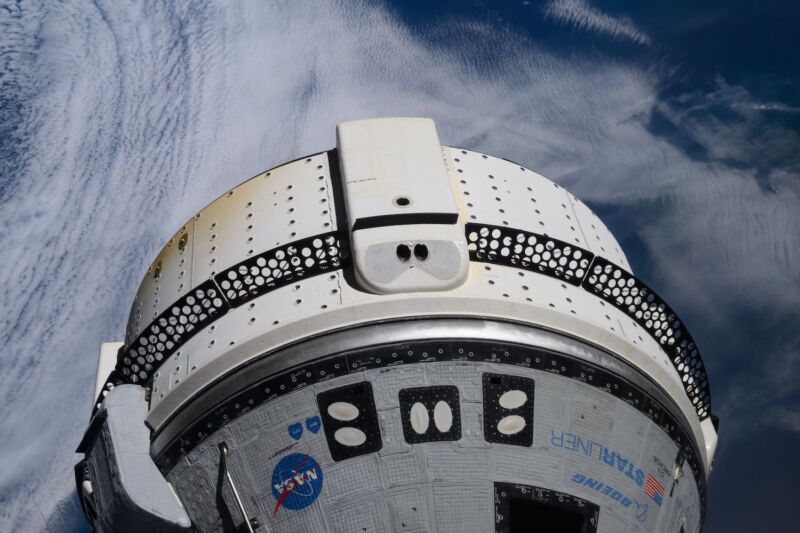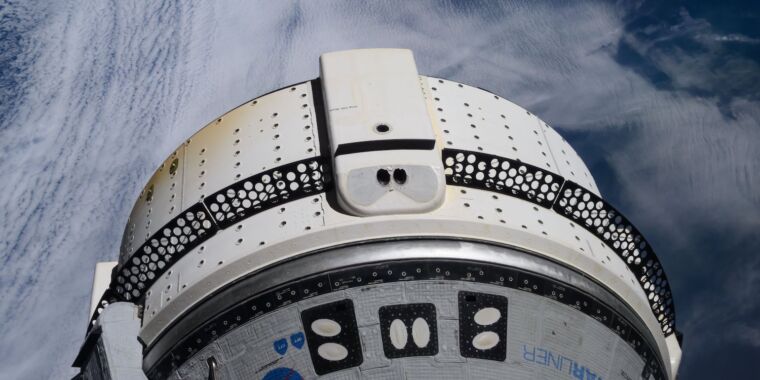
NASA
Boeing’s Starliner spacecraft will gently back away from the International Space Station Friday evening, then fire its balky thrusters to rapidly depart the vicinity of the orbiting lab and its nine-person crew.
NASA asked Boeing to adjust Starliner’s departure sequence to get away from the space station faster and reduce the workload on the thrusters to reduce the risk of overheating, which caused some of the control jets to drop offline as the spacecraft approached the outpost for docking in June.
The action begins at 6:04 pm EDT (22:04 UTC) on Friday, when hooks in the docking mechanism connecting Starliner with the International Space Station (ISS) will open, and springs will nudge the spacecraft away its mooring on the forward end of the massive research complex.
Around 90 seconds later, a set of forward-facing thrusters on Starliner’s service module will fire in a series of 12 pulses over a few minutes to drive the spacecraft farther away from the space station. These maneuvers will send Starliner on a trajectory over the top of the ISS, then behind it until it is time for the spacecraft to perform a deorbit burn at 11:17 pm EDT (03:17 UTC) to target landing at White Sands Space Harbor, New Mexico, shortly after midnight EDT (10 pm local time at White Sands).
How to watch, and what to watch for
The two videos embedded below will show NASA TV’s live coverage of the undocking and landing of Starliner.
Starliner is leaving its two-person crew behind on the space station after NASA officials decided last month they did not have enough confidence in the spacecraft’s reaction control system (RCS) thrusters, used to make exact changes to the capsule’s trajectory and orientation in orbit. Five of the 28 RCS thrusters on Starliner’s service module failed during the craft’s rendezvous with the space station three months ago. Subsequent investigations showed overheating could cause Teflon seals in a poppet valve to swell, restricting the flow of propellant to the thrusters.
Engineers recovered four of the five thrusters after they temporarily stopped working, but NASA officials couldn’t be sure the thrusters would not overheat again on the trip home. NASA decided it was too risky for Starliner to come home with astronauts Butch Wilmore and Suni Williams, who launched on Boeing’s crew test flight on June 5, becoming the first people to fly on the commercial capsule. They will remain aboard the station until February, when they will return to Earth on a SpaceX Dragon spacecraft.
The original flight plan, had Wilmore and Williams been aboard Starliner for the trip home, called for the spacecraft to make a gentler departure from the ISS, allowing engineers to fully check out the performance of its navigation sensors and test the craft’s ability to loiter in the vicinity of the station for photographic surveys of its exterior.
“In this case, what we’re doing is the break-out burn, which will be a series of 12 burns, each not very large, about 0.1 meters per second (0.2 mph) and that’s just to take the Starliner away from the station, and then immediately start going up and away, and eventually it’ll curve around to the top and deorbit from above the station a few orbits later,” said Anthony Vareha, NASA’s flight director overseeing ISS operations during Starliner’s undocking sequence.
Astronauts won’t be inside Starliner’s cockpit to take manual control in the event of a major problem, so NASA managers want the spacecraft to get away from the space station as quickly as possible.
On this path, Starliner will exit the so-called approach ellipsoid, a 2.5-by-1.25-by-1.25-mile (4-by-2-by-2-kilometer) invisible boundary around the orbiting laboratory, about 20 to 25 minutes after undocking, NASA officials said. That’s less than half the time Starliner would normally take to leave the vicinity of the ISS.
“It’s a quicker way to get away from the station, with less stress on the thrusters,” said Steve Stich, NASA’s commercial crew program manager. “Essentially, once we open the hooks, the springs will push Starliner away and then we’ll do some really short thruster firings to put us on a trajectory that will take us above the station and behind, we’ll be opening to a nice range to where we can execute the deorbit burn.”
In the unlikely event of a more significant series of thruster failures, the springs that push Starliner away from the station should be enough to ensure there’s no risk of collision, according to Vareha.
“Then, after that, we really are going to just stay in some very benign attitudes and not fire the the thrusters very much at all,” Stich said.
Starliner will need to use the RCS thrusters again to point itself in the proper direction to fire four larger rocket engines for the deorbit burn. Once this burn is complete, the RCS thrusters will reorient the spacecraft to jettison the service module to burn up in the atmosphere. The reusable crew module relies on a separate set of thrusters during reentry.
Finally, the capsule will approach the landing zone in New Mexico from the southwest, flying over the Pacific Ocean and Mexico before deploying three main parachutes and airbags to cushion its landing at White Sands. Boeing and NASA teams there will meet the spacecraft and secure it for a road voyage back to Kennedy Space Center in Florida for refurbishment.
Meanwhile, engineers must resolve the causes of the thruster problems and helium leaks that plagued the Starliner test flight before it can fly astronauts again.

